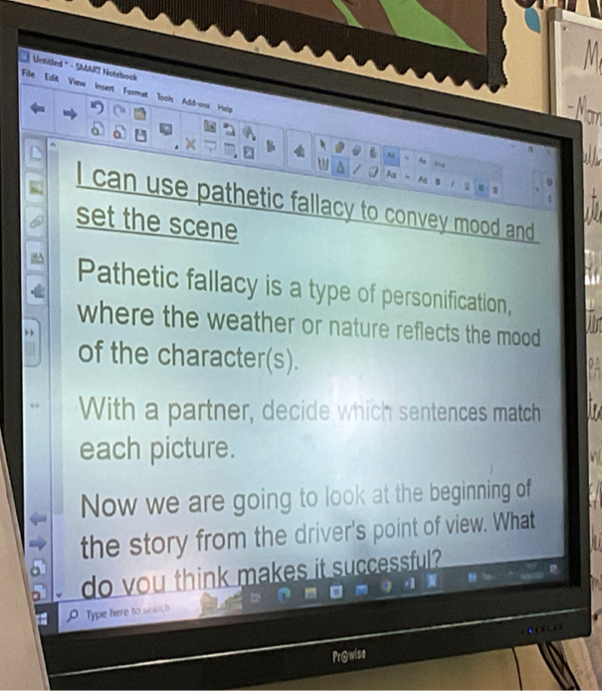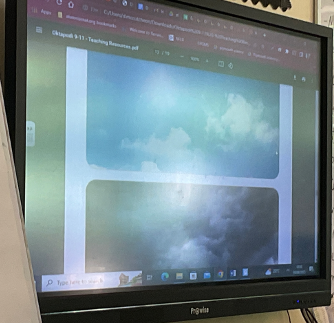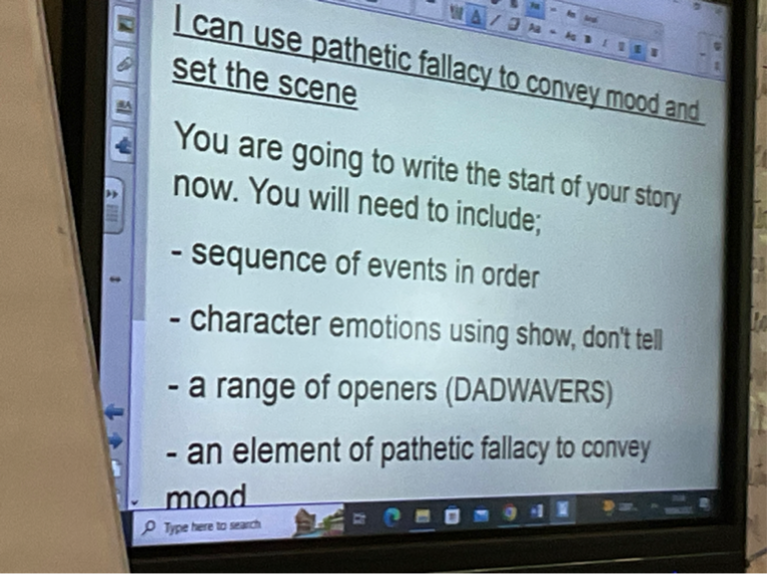Lesson Commentary
Teacher explains the focus for this activity
Children come back in the class and sit down with their writing books on their tables. Some have their Chromebooks open, but many children packed their Chromebooks away before the break and most of these Chromebooks remain in the bag during the plenary. One child sits on the table with the chargers, keeping the Chromebook on his lap (assuming the laptop needs charging while he is referring to it. He has one of the Padlets open). The teacher stands in front of the IWB at the front of the class.
The teacher starts the plenary with saying that the “session is going to be a long one” followed by saying the children can close their Chromebooks as they won’t need them for the first part. Almost instantly, all children who had their Chromebooks open on the table, close the lid of their Chromebook. The laptops immediately cease to be a distracting factor in the class and the child sitting on the table returns to his seat.
The teacher explains that the learning objective of this session is a new one: “I can use pathetic fallacy to convey mood in a scene”. The class has discussed pathetic fallacy before, and the children are told they do not need to remember the exact words, but that “what we are trying to do is set the scene for our story”. The teacher reminds the children of a previous activity where they did work on setting the scene in a story. Throughout the explanation, he points to the IWB, where the objectives of this lesson are displayed.

Lesson 2, Activity 1
The teacher also refers to the wall display (the ‘writing wall’), where information about ‘personification’ is displayed in the form of examples of figurative language. Children immediately turn around to look at the wall display, while he is pointing out where to find the information. One of the children raises their hand and asks a question about the previous activity where they used personification (a reference is made to the film ‘Alma’ that they used before in writing lessons) and the teacher explains how they can use this in the current activity.
Paired activity: The children explore the mood that is conveyed in pre-written sentences
At this point, the teacher hands out a new handout with a list of sentences, and in pairs, the children need to match the pictures on the board (IWB) with the sentences on the handout. The children get 2 minutes to go through each of the statements to decide whether it belongs to Picture A or Picture B. Most children immediately set out to talk to the person sitting next to them, but as grouping is informal, not all children talk to a peer. A few look at the handout and the pictures on their own, while the teacher walks around the class and checks on children’s ideas. He sounds a bell after 2 minutes to quieten the children, and they immediately raise their hands to contribute their ideas to the rest of the class. Children are invited to read out the statements and match them to the pictures on the IWB. All children are asked to provide input to the plenary, by giving a ‘thumbs up’ or ‘thumbs down’ if they agree with the suggestion about a statement, and most children in the class participate.

Matching sentences to pictures to learn about pathetic fallacy to convey mood
Example of a beginning of a story from a character’s point of view: invoking a community of authors
The next part of the activity starts with an example of the beginning of the story, written from one character’s point of view. The teacher begins by referring to previous lessons, linking to prior learning, again through a reference to the film ‘Alma’. He presents the current lesson firmly as a writing lesson, invoking and emphasising the students’ identities as ‘authors’. (“We have also talked about how in film, it is easy to show different things, so in Alma, the director fades out a bit of colour, so everything has a sort of ‘greyness’ to it, which creates a particular feel to the story. As authors, we have to do that all through words”). The teacher shifts back to the original aims of the activity on the IWB, and explains that he will show the children an example of a start of a story, written from the perspective of the driver (one of the characters in the Oktapodi film). The children are reminded that it would be good if they could “produce something like this, but don’t feel that this is what you need to do”. It is clear that children are given the opportunity to be creative, within the constraints of the narrative of the film, which acts as a scaffold.
The teacher presents a possible beginning of the story on the IWB and asks some children to read it aloud. Children are invited to share what they think works well, and what kinds of ideas they can use in their own stories. The teacher then moves back to the ‘writing wall’ and points out the DADWAVERS display. Children are reminded that this mnemonic helps them to vary the sentences, and again, all children look at the display board and share their ideas about different sentences using the DADWAVERS mnemonic.
There is a strong multi-directional focus as part of the composing process in this activity. Children are engaged and focus their attention to various displays, screens and to the teacher, as the activity goes on. Throughout the activity, they are willing to engage, and seem happy to share their ideas with the rest of the class. They pay attention to the teacher and to other students when things are said, raise their hands when asked questions, contribute with ideas when asked, and focus their attention to where the teacher is directing their gaze.
Towards the end of the activity, the students are reminded of ‘The Oktapodi folder’ where they can find a file called ‘Oktapodi teacher resources’. The teacher tells them he has saved the example beginning in this folder, and if they want to have a look, they can find it there. He explains that in the past, he would have printed this out, but that he now just points the children to the folder where to find the resource on their Chromebook.

Writing aims
To finish this activity, the teacher flips back to the writing activity’s aims on the IWB, and asks “who is excited to start writing their story?”. Almost all hands fly up. He recaps the activity as follows;
- You are writing the story from one of the characters’ point of view
- Do not worry about the inner monologue at this point, we’re going to add that in at the end
- You are writing from the first person; write as that person
- You have got your Padlets to keep you on track with how the story happens and you can watch the story if you forget what happens next
- We’d like to see ‘show not tell’ and a variety of sentence openers (pointing to DADWAVERS – “that was something that was really missing in the Alma piece of writing”)
- Add an element of pathetic fallacy to convey mood
The children are reminded that they can have another look at the beginning of the film. This is quite a short clip, but the children are challenged to write around half a page, to set the scene. One of the children asks about providing a made-up backstory, and the teacher explains he wants them to focus on the current scene, and not to spend too much time providing the backstory. They are told to only use a couple of sentences for that.
Observations about enjoyment and engagement
Children readily engage in the activity, evidenced by an almost immediate hum of peer talk. They are keen to share and discuss their ideas with one another. The IWB is used as a static support to scaffold the discussion, while the laptops remain closed. Children are focused on their papers and on the IWB, and occasionally point to the wall displays, and remain firmly focused on their small-group discussions until the teacher begins the plenary.
